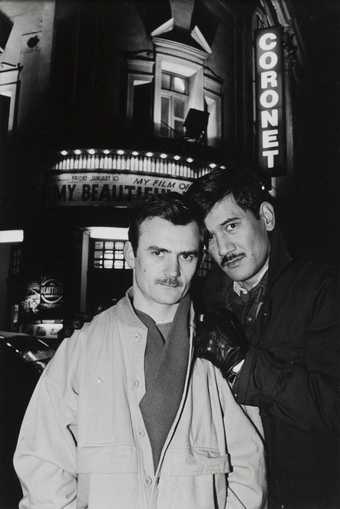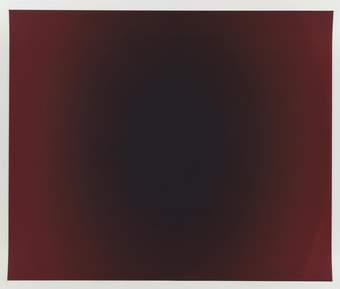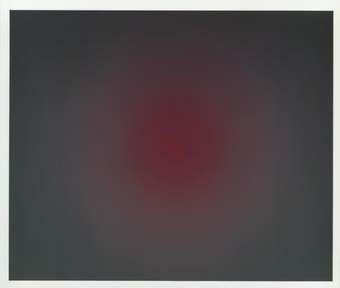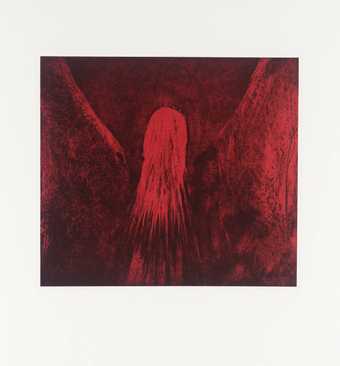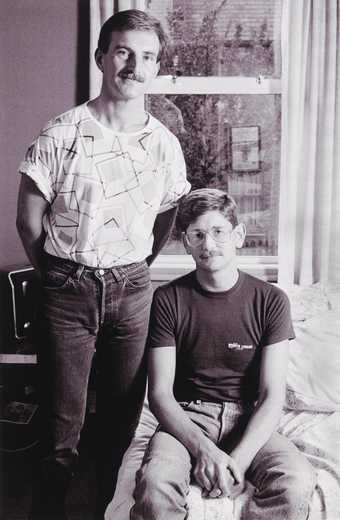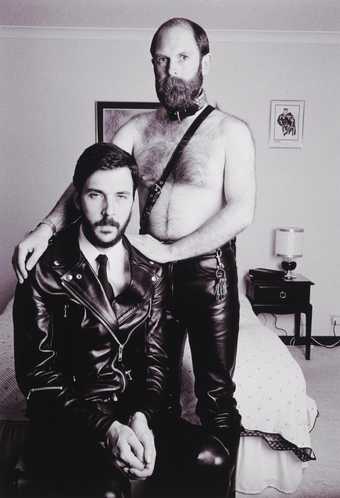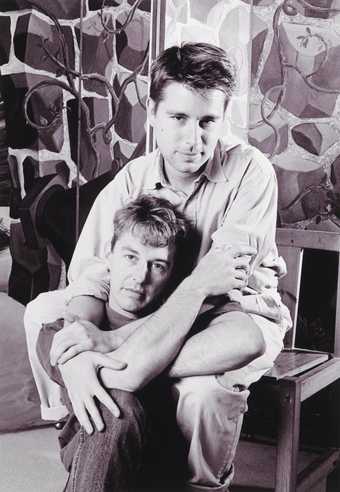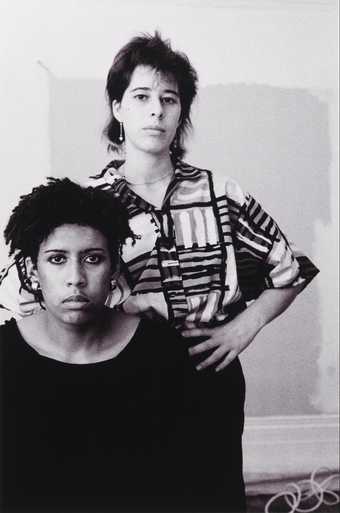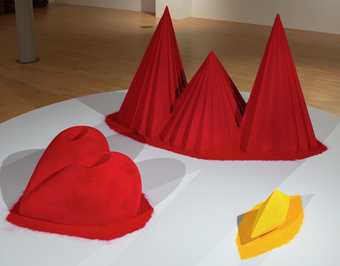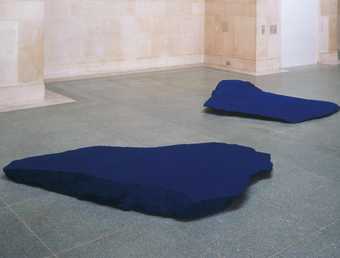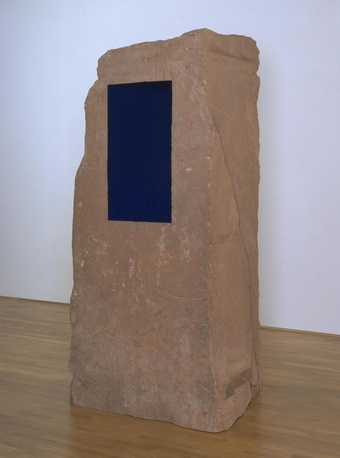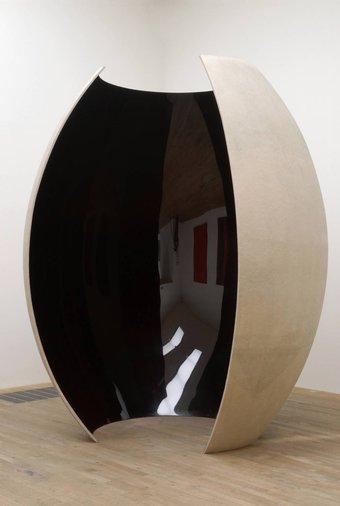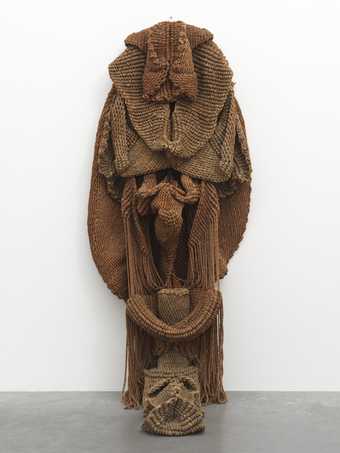
Not on display
- Artist
- Mrinalini Mukherjee 1949–2015
- Medium
- Hemp fibre and steel
- Dimensions
- Object: 1430 × 1330 × 1100 mm
- Collection
- Tate
- Acquisition
- Presented by Amrita Jhaveri 2013
- Reference
- T14458
Summary
Jauba (Hibiscus) 2000 is a freestanding sculpture that was created by knotting yarn made from dyed hemp fibre over a vertical metal armature, with the bulk of its woven detail on the front. The yarn has been dyed red, green and black and is woven into pleated organic forms which drape the frame like a robe. ‘Jauba’ means hibiscus in the artist’s native language Bengali. Visually, the sculpture resembles a botanical, floral form, roughly symmetrical, which droops slightly towards the floor due to the weight of the material.
Hemp yarn is a ubiquitous material in both urban and rural India, a natural rope used for multiple purposes including string cots and beds. Jauba is the culmination of the artist’s ongoing experimentation with the material, which she has used since 1971. As a student Mukherjee studied painting, specialising in mural painting at the Faculty of Fine Arts at Maharaja Sayajirao University in Baroda. She studied with the prominent artist and pedagogue K.G. Subramanyan (born 1924), whose work on ‘living traditions’ or reworking traditional craft forms and indigenous materials was formative as she developed her sculptural practice. Mukherjee later worked in both ceramic and bronze.
In India Mukherjee has been recognised as an innovator, an artist making a radical departure from European models of modern sculpture and evolving her own material processes rather than employing the more popular stone, wood or bronze (J. Swaminathan, ‘Pregnant with the Sap of Fecundity’, in Museum of Modern Art Oxford 1994, p.6). Mukherjee has a preference for natural rather than industrial materials, an interest which aligns her with a number of arte povera artists as well as contemporaries from other continents. ‘It is through my relationship with my material,’ she has said, ‘that I would like to reach out and align myself with the values which exist within the ambit of contemporary sculpture’ (Mrinalini Mukherjee, ‘An Interview with Mrinalini Mukherjee’, in Museum of Modern Art Oxford 1994, p.11).
Integral to Mukherjee’s practice is the labour involved in production. The fibre for each work was first hand-dyed (using commercial dyes) then built up knot by knot to create a textile mesh, working from both observation and free imagination, and inspired by anthropomorphic and biomorphic forms. While some sculptures are overtly figurative, others are derived from plant or flower forms and all are imbued with an organic, lifelike presence due to the natural qualities of the material. Mukherjee describes the process as an ‘unfolding’ or ‘quite literally a process of growth, the grammar of which creates an order, which in turn is expounded through improvisation’ (Mukherjee 1994, p.11).
In works such as Jauba, where the central pink area has a strong visual association with female genitalia, Mukherjee also directly addresses issues of female sexuality through the use of tactile labial forms. Cultural references are also coded into the titles of specific works, evoking either sacred forms or the traditional botanical names of flowers (for example Yogini 1984, meaning ‘female yoga master’, or Pushp 1993, meaning ‘bloom’). While aware of the obvious connections with sexuality as expressed in sacred Hindu sculpture, the artist prefers not to relate her work directly to any specific formal iconographic tradition, explaining that her stylistic choices are based on her interest in nature and her individual experiences. She has said, ‘I work emotionally and intuitively and do not like analysing my feelings during the work process, as I feel it will hinder the nascent image in mind’ (Mukherjee 1994, pp.13–14).
Jauba was shown in the exhibition India Moderna at the Institut Valencià d’Art Modern (IVAM) in Valencia in 2008.
Further reading
Tania Guha, ‘Mrinalini Mukherjee: Labyrinths of the Mind’, Third Text, vol.8, nos.28–9, 1994, pp.165–8.
‘As flowers turn their heads towards the sun…’ Mrinalini Mukherjee: Sculptures in Bronze, exhibition catalogue, Vadehra Art Gallery, New Delhi 2007.
India Moderna, exhibition catalogue, Institut Valencià d’Art Modern (IVAM), Valencia 2008, reproduced p.251.
Nada Raza
January 2013
Does this text contain inaccurate information or language that you feel we should improve or change? We would like to hear from you.
You might like
-
Sunil Gupta Untitled from the series Reflections of the Black Experience
1986, printed 2010 -
Sunil Gupta Ian and Julian, from the series Ten Years On
1986, printed 2010 -
Sir Anish Kapoor CBE RA [no title]
1998 -
Sir Anish Kapoor CBE RA [no title]
1998 -
Sir Anish Kapoor CBE RA [no title]
2000 -
Sir Anish Kapoor CBE RA [no title]
2000 -
Sunil Gupta John & John, London
1985, printed 2018 -
Sunil Gupta Dylan & Gerald, London
1985, printed 2018 -
Sunil Gupta Simon & John-Paul, London
1985, printed 2018 -
Sunil Gupta Lisa & Emily, London
1984, printed 2018 -
Sir Anish Kapoor CBE RA As if to Celebrate, I Discovered a Mountain Blooming with Red Flowers
1981 -
Sir Anish Kapoor CBE RA A Wing at the Heart of Things
1990 -
Sir Anish Kapoor CBE RA Adam
1988–9 -
Sir Anish Kapoor CBE RA Ishi’s Light
2003 -
Mrinalini Mukherjee Ritu Raja
1977

